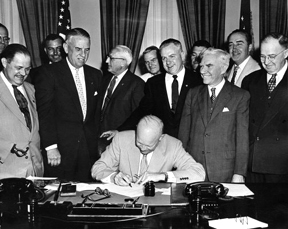155mm artillery is our current and only ‘Big Gun’
And FYI, that TNT manufacturing plant that was in the U.S. was just down the road at Carthage MO.
The new plant will be at Graham, KY.
An atrophied defense production base is one obvious sign of national decadence — and not the fun kind. – Stephen Green
Army Falls Short of 155mm Production Goal.
The Army — in response to diminishing stockpiles as it supported Ukraine’s defense against Russia — set a goal to produce 100,000 155mm artillery rounds per month by this October.
The service opened a number of new facilities to support this endeavor — and as one Army official stated, “We haven’t seen this level of investment in our industrial base since World War II.”
However, the Army is going to fall short of its goal. Service spokesperson Steve Warren told reporters in July that the Army is not expecting to produce 100,000 155mm rounds per month until mid-2026.
The service is currently producing 40,000 rounds per month, Warren said — the same amount it was producing as of September 2024, according to a Defense Department release.
There are a “whole host of reasons” behind the stagnation in 155mm production, said Maj. Gen. John Reim, joint program executive officer for armaments and ammunition and commanding general of Picatinny Arsenal.
One challenge has been the supply chain for production equipment, Reim said in an interview.
“For a lot of this equipment that we need to rapidly expand capacity, it’s not sitting on a shelf somewhere,” and the Army has had to depend on international suppliers, he said. “We’ve [been] experiencing longer than expected lead times with some of that capability, and that has a cascading effect.”
It has also taken time for some of the service’s industry partners to ramp production up to the desired rates. The Army recently issued a cure notice to General Dynamics Ordnance and Tactical Systems due to poor performance at a modular metal parts facility in Mesquite, Texas, Reim said.
General Dynamics declined to comment for this story.
The language in the cure notice “is intentionally harsh, and it describes potential options, to include … termination,” Reim said. The service’s role is to hold “our industry partner accountable — we owe that to our taxpayers — and where we’re at in terms of our 155 ramp, this is on the critical path, and so we want to ensure they’re successful.”
The Army had just received General Dynamics’ response to the cure notice when National Defense spoke to Reim in mid-July. The Army intends to continue working with the company and “understand the risks and what a realistic schedule looks like, and if there [are] things that we can do to help mitigate the risk to ensure that we get this up and running,” he said.
The service and its industry partners have “realized some risk” bringing in “new and novel 21st-century technologies that really haven’t proven to be able to produce 155,” Reim noted.
At the Mesquite facility, the Army and General Dynamics have brought in capabilities such as flow-forming technology — which uses rollers to shape a round’s metal parts — that have never been used for 155mm production, Reim said. “While all that equipment is installed, now we’re in the process” of ensuring those systems produce parts that conform to the service’s requirements.
“If we don’t have a conforming round, then that can be catastrophic to the equipment and potentially the crew,” he said. “So, it’s something that’s kind of no-fail for us.”
Other companies in the 155mm supply chain are modernizing their production capabilities.
Andy Davis, vice president of engineering and strategy at Nammo Defense Systems, said the company is incorporating new automated manufacturing technologies at its Mesa, Arizona, facility, where it produces 155mm projectiles and base bleed grains.
“Although the technology of the 155mm base bleed round relies on legacy propellant formulation,” with these new technologies, Nammo is creating an “efficient, high-volume propellant grain production capability that minimizes touch labor and improves quality,” Davis said in an email.
John McGuinness, president of munitions and government at Day & Zimmermann, said in an email the company has significantly expanded its use of robotics, data-driven process controls and digital quality assurance systems.
Day & Zimmermann in March reached an all‑time production high, turning out nearly 45,000 M795 155mm rounds — “a milestone that reflects both our workforce’s dedication and the effectiveness of our ongoing modernization efforts,” McGuinness said.
While 155mm production isn’t currently at the desired rate, the Army has experienced successes during the ramp-up, Reim said.
A metal parts production facility in Ingersoll, Canada, managed by IMT Group experienced a labor strike during its build and commissioning phase, but the plant is now producing 3,000 shell bodies a month, he said.
“We’re ramping to 10,000 later this summer,” with the goal to eventually produce 15,000 shell bodies per month at the facility, he added.
The Army in October 2024 held ribbon-cutting ceremonies at a pair of facilities in Marion, Illinois, and Perry, Florida, that will produce M119A2 red bag propelling charges for 155mm rounds, opening those plants two months ahead of schedule, he said.
In November, the Army awarded a $435 million contract to Repkon USA to establish a production facility in Graham, Kentucky, for TNT — the primary explosive fill for 155mm shells.
“We stopped making TNT in the U.S. in 1986, and we were buying from the Russians. We were buying from the Ukrainians,” Reim said. “Obviously, the Russians aren’t a source anymore,” while a Ukrainian production facility was destroyed early on in the war.
The Army is dependent today on Polish TNT and has also sourced it from Australia, South America and Asia, he said. “So, we’re excited … to bring that back to the U.S.”
Additionally, the service and General Dynamics Ordnance and Tactical Systems in April opened a new 155mm load, assemble and pack facility in Camden, Arkansas, that will produce completed high-explosive projectiles at a rate of 50,000 per month when fully operational, an Army release stated.
“So, it’s not all bad news,” Reim said.
However, the Army’s struggle to ramp up 155mm production “raises questions about our ability to surge production in an emergency,” said Mark Cancian, a senior adviser in the defense and security department at the Center for Strategic and International Studies.
While production ramp-ups like this are “always complicated … if it turns out to be much more difficult than we had thought, then that makes a surge strategy more difficult” in the event of crisis or conflict, Cancian said in an interview.
Jerry McGinn, director of CSIS’s Center for the Industrial Base, said in an email that the Army’s struggles to meet its 155mm production goals are linked to the state of the industrial base before the Russian invasion of Ukraine.
“The industrial base builds capacity to the terms of existing and expected future contracts, and there was no demand signal for a potential production ramp-up prior to Russia’s invasion of Ukraine,” McGinn said. “The industrial base has responded to the production ramp-up, but that took time.”
Reim noted that prior to the invasion, the service was producing 14,000 155mm rounds per month — “that was, frankly, optimized for what we shoot during the course of the year in support of training operations for the Army and the Marine Corps.”
When the Army “looked at what it was going to take to surge, we quickly realized it wasn’t just production capacity, it was supply chain,” he said. “And when we looked, there [were] a number of single points of failure that didn’t have surge capacity to meet the rapid requirements.”
Cancian said: “The closer we are towards a production capability, the higher confidence we can have in surge. And by that I mean if we have machinery that is in the back room in a state of preservation, that gives us some level of confidence. If we have a production line that is next to the primary production line, and we use it two weeks a year just to make sure it works, that gives us even more confidence.
“But if all you have is a bunch of drawings in the back room and some notion that you’re going to build a new building and institute a new production facility — which is where we were — that gives you much less confidence,” he said.
However, maintaining that capacity is expensive, especially in peacetime when you don’t need to surge production, and doing so could appear wasteful, Cancian said. The Army will “have to have a comeback to that and be willing to argue for maintaining these surge capabilities.”
Reim said one way the Army is looking to keep its 155mm production capacity active going forward is through foreign military sales.
“Our European partners are right behind us in terms of their” 155mm production ramp-up, “and I think they’re going to experience a lot of the same challenges we have experienced,” he said. “I think our capacity could help satisfy some of their near-term requirements.”
Meanwhile, the Ukrainian Defense Industry Joint Stock Company and Florida-based ammunition and primer manufacturer D&M Holding Company Inc. in July announced a joint venture to produce propellant for artillery ammunition, including 155mm shells, at a new U.S.-based facility.
Oleh Huliak, director general of the Ukrainian Defense Industry Joint Stock Company, said in a press release: “We have to gradually move from large-scale procurement to our own production to meet our immediate needs. It is equally important that the company will operate in a safe area.”
D&M Holding Company Inc. President and CEO Dan Powers and Executive Vice President James Jones said in an email that production will begin at the new facility in mid-2026, and the propellant will be available to other 155mm producers.
While the Army failed to meet its initial timeline for its 155mm production ramp-up, producing 100,000 rounds per month is still the goal, Reim said.
“We’ve got the resourcing. We’ve got a lot of the authorities that have enabled us to get money and execution,” he said.
It has taken a “whole-of-government approach to get after this,” and “we’re working hard with our industry partners, and we’re going to hold them accountable when they’re not meeting their contract requirements,” he said.





